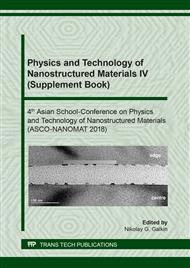p.93
p.100
p.106
p.113
p.118
p.124
p.130
p.136
p.142
Hydrothermal Synthesis and Study of the Properties of the System ZrW2-xMoxO7(OH)2·2H2O (0≤x≤2)
Abstract:
The ZrW2-xMoxO8 (0≤x≤2) system has a unique property - a negative coefficient of thermal expansion (CTE), that is it shrinks when heated. Such materials solve the problem of undesirable thermal expansion of composites in many areas. In contradistinction to ZrW2O8 and ZrMo2O8, this system has anomalously low CTE values [1,2] and adverse phase transition is shifted to a lower temperature, unlikely area for operation [3,4]. At the same time, the fundamental question remains about the mechanism of formation of ZrW2-xMoxO8(0≤x≤2). According to [5,6], pure cubic ZrW2O8 and ZrMo2O8 are obtained by thermal decomposition of the precursor ZrM2O7(OH)2· 2H2O, where (M = Mo, W). However, the structure of the precursor is extremely sensitive to various changes in the synthesis process. To date, there are a number of works devoted to the hydrothermal synthesis of precursors ZrW2-xMoxO7(OH)2·2H2O (0≤x≤2) solid solutions, however, not all formulations were obtained during the hydrothermal reaction. The study of their thermal properties, as well as structural and phase transformations are not fully studied. Within the paper it was first time proposed to obtain full number of nanosized materials by the hydrothermal method and also to study the nature of the thermal expansion of each member of the solid solution. The obtained data will solve many technical problems associated with dimensional nonvariance in the electronic, oil and gas, optical industry, medicine and rocket engineering.
Info:
Periodical:
Pages:
118-123
Citation:
Online since:
June 2019
Price:
Сopyright:
© 2019 Trans Tech Publications Ltd. All Rights Reserved
Share:
Citation:


